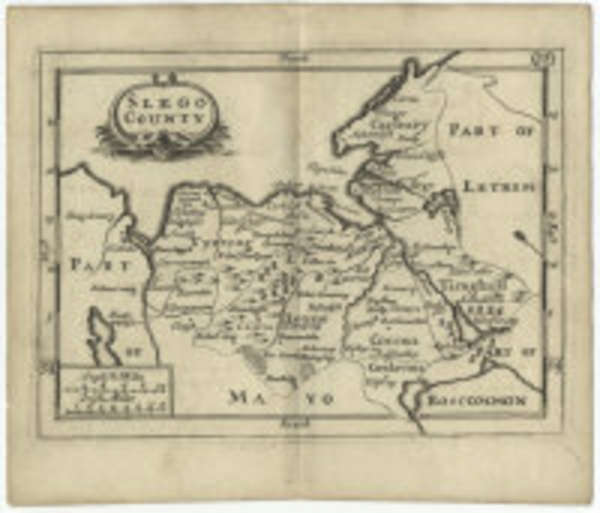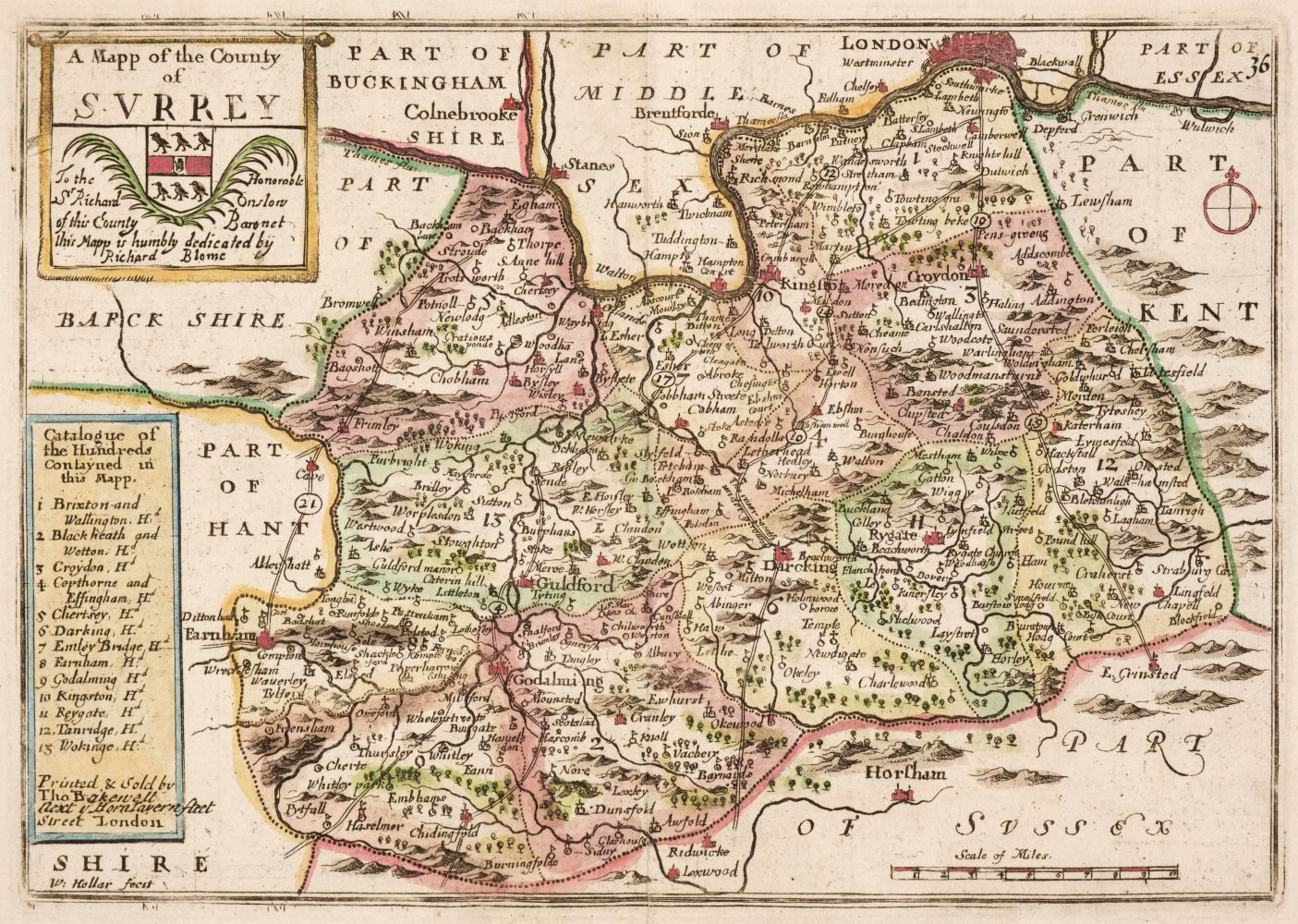SELLER, John. [ A Mapp of New Jersey in America . London: John Seller ?1677]. Copper-engraving (430 x 802 mm), printed on three sheets (a central rectangle to which two narrow flanking panels were added). (Bottom edge damaged with losses to image and border, two small losses at upper left-hand portion along old fold, other minor defects, professionally mended from the verso.) Provenance : Originally part of the Minute Book of the Lords Proprietors of East Jersey (see lot 9). THE FIRST PRINTED MAP OF NEW JERSEY, A UNIQUE PROOF STATE OF THE ENLARGED VERSION, SHOWING PART OF THE NEW COLONY OF PENNSYLVANIA. This extremely rare map is the first map to show--although inaccurately--the Quintipartite Line (1676) which divided the two proprietorships of East and West Jersey. It is a projection from an unusual angle: looking west, the Hudson River runs horizontally along the lower portion, with the Quintipartite Line disposed along the horizontal centerline. The Jersey shore, with Little Egg Harbor, present-day Long Beach Island and Cape May extend diagonally towards the top left corner, showing Delaware Bay. Many place names are given by the map-maker along the Delaware, extending well into the hinterlands, and the headwaters are shown connecting to the Wallkill and Esopus, thence to the Hudson. In the center is a nice view of a stockaded Indian town and in New York Bay is a small image of "Indian canoes...Boats made from ye barke of trees." The area around Manhattan Island includes Elizabethtowne, Gravesend, Flatbush, "Conny Island" and a host of other landmarks, many with Indian or Dutch names. In the lower left is a large oblong inset of the "restitutio" view of New York City (damaged, unfortunately, but in early state), including the Fort with flagpole, a large Church, and gun emplacements along the Battery. In an analysis of the Blathwayt Atlas, Jeanette D. Black notes that Seller's map was a result of William Penn's decision to establish a Quaker colony in West New Jersey and was a "device intended by him to attract potential settlers and investors to the West Jersey colony." Black dates the two earliest states of the map to ca 1674, but early 1675 or 1676 seems more likely, since the few surviving examples are found in copies of Seller's composite Atlas Maritimus , whose title is dated 1675. Some copies of the atlas, though, were issued later with the older printed title. The map is of the enlarged form, revised in 1677 by the addition of flanking sheets to extend the area depicted. The right-side addition depicts the upper Delaware River watershed, erroneously showing the headwaters of the Wallkill River connecting to the Delaware, thereby predicating a continuous water route extending from the Delaware to the Hudson! The new version also substituted a new view of New York, the "Restitutio View," as an inset, replacing the old and very outdated Visscher view of New York, which showed Manhattan as it appeared during the Dutch ascendancy. The map's title was altered to read A Mapp of New Jersey in America, by John Seller and Fisher . The enlarged state of the Seller map is extremely rare, with just six complete or partial copies located (complete copies are at John Carter Brown Library and the Garrett Collection, Johns Hopkins; incomplete copies at the British Library, New York Public Library and the Public Record Office, London. One copy was offered in a 1991 sale). A unique proof copy of the map exists in a volume of maps in the Samuel Pepys Library, Magdalene College, Cambridge; it is without the title and the dedicatory text, and the "Restitutio View" of New York is unfinished, lacking the later hatching. It would appear to constitute a proof state of the enlarged version (although Black designated it state 3). The present map from the Minute Book seems to correspond with the Pepys proof copy, but Black notes that in the Pepys proof copy, "the engraver's name no longer appears in the lower right" of the right-hand sheet
SELLER, John. [ A Mapp of New Jersey in America . London: John Seller ?1677]. Copper-engraving (430 x 802 mm), printed on three sheets (a central rectangle to which two narrow flanking panels were added). (Bottom edge damaged with losses to image and border, two small losses at upper left-hand portion along old fold, other minor defects, professionally mended from the verso.) Provenance : Originally part of the Minute Book of the Lords Proprietors of East Jersey (see lot 9). THE FIRST PRINTED MAP OF NEW JERSEY, A UNIQUE PROOF STATE OF THE ENLARGED VERSION, SHOWING PART OF THE NEW COLONY OF PENNSYLVANIA. This extremely rare map is the first map to show--although inaccurately--the Quintipartite Line (1676) which divided the two proprietorships of East and West Jersey. It is a projection from an unusual angle: looking west, the Hudson River runs horizontally along the lower portion, with the Quintipartite Line disposed along the horizontal centerline. The Jersey shore, with Little Egg Harbor, present-day Long Beach Island and Cape May extend diagonally towards the top left corner, showing Delaware Bay. Many place names are given by the map-maker along the Delaware, extending well into the hinterlands, and the headwaters are shown connecting to the Wallkill and Esopus, thence to the Hudson. In the center is a nice view of a stockaded Indian town and in New York Bay is a small image of "Indian canoes...Boats made from ye barke of trees." The area around Manhattan Island includes Elizabethtowne, Gravesend, Flatbush, "Conny Island" and a host of other landmarks, many with Indian or Dutch names. In the lower left is a large oblong inset of the "restitutio" view of New York City (damaged, unfortunately, but in early state), including the Fort with flagpole, a large Church, and gun emplacements along the Battery. In an analysis of the Blathwayt Atlas, Jeanette D. Black notes that Seller's map was a result of William Penn's decision to establish a Quaker colony in West New Jersey and was a "device intended by him to attract potential settlers and investors to the West Jersey colony." Black dates the two earliest states of the map to ca 1674, but early 1675 or 1676 seems more likely, since the few surviving examples are found in copies of Seller's composite Atlas Maritimus , whose title is dated 1675. Some copies of the atlas, though, were issued later with the older printed title. The map is of the enlarged form, revised in 1677 by the addition of flanking sheets to extend the area depicted. The right-side addition depicts the upper Delaware River watershed, erroneously showing the headwaters of the Wallkill River connecting to the Delaware, thereby predicating a continuous water route extending from the Delaware to the Hudson! The new version also substituted a new view of New York, the "Restitutio View," as an inset, replacing the old and very outdated Visscher view of New York, which showed Manhattan as it appeared during the Dutch ascendancy. The map's title was altered to read A Mapp of New Jersey in America, by John Seller and Fisher . The enlarged state of the Seller map is extremely rare, with just six complete or partial copies located (complete copies are at John Carter Brown Library and the Garrett Collection, Johns Hopkins; incomplete copies at the British Library, New York Public Library and the Public Record Office, London. One copy was offered in a 1991 sale). A unique proof copy of the map exists in a volume of maps in the Samuel Pepys Library, Magdalene College, Cambridge; it is without the title and the dedicatory text, and the "Restitutio View" of New York is unfinished, lacking the later hatching. It would appear to constitute a proof state of the enlarged version (although Black designated it state 3). The present map from the Minute Book seems to correspond with the Pepys proof copy, but Black notes that in the Pepys proof copy, "the engraver's name no longer appears in the lower right" of the right-hand sheet















Testen Sie LotSearch und seine Premium-Features 7 Tage - ohne Kosten!
Lassen Sie sich automatisch über neue Objekte in kommenden Auktionen benachrichtigen.
Suchauftrag anlegen